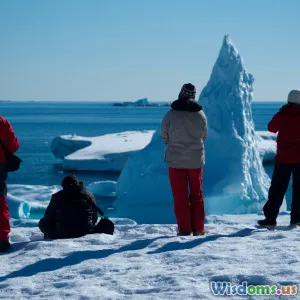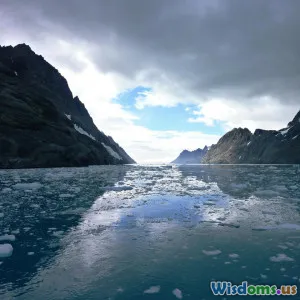
The Freezing Truth About Arctic Camping Gear Failures
7 min read Explore critical Arctic camping gear failures, learn causes, and discover survival tips for freezing expeditions. (0 Reviews)
The Freezing Truth About Arctic Camping Gear Failures
Camping in the Arctic isn't just about braving cold—it’s about trusting your gear against some of Earth's most unforgiving conditions. Here, even minor equipment flaws can escalate into life-threatening situations. For adventurers and researchers who venture into this icy frontier, understanding the vulnerabilities in their equipment is crucial. This comprehensive exploration reveals the chilling reality behind Arctic camping gear failures, highlights significant case studies, and provides actionable advice to prevent disaster.
I. Understanding the Arctic Environment and Its Challenges
The Arctic climate is notorious for its extreme cold, high winds, and rapid weather swings. Temperatures can plummet below -40°C (-40°F), with wind chills making it feel even colder. Such environmental stresses affect both humans and their equipment. Moisture can freeze instantly, batteries die prematurely, and materials become brittle.
Why is Arctic camping gear more susceptible to failure?
- Extreme Temperatures: Metals become brittle; plastics can crack.
- Condensation and Ice Build-Up: Moisture condenses inside gear, freezes, causing malfunctions.
- Wind and Abrasion: High-velocity winds erode textiles and weaken structural integrity.
According to a 2020 study by the Cold Regions Research and Engineering Laboratory (CRREL), at temperatures below -30°C, battery-powered devices can lose up to 60% of their effective charge within hours.
II. The Most Common Gear Failures in Arctic Camping
1. Sleeping Bags and Insulation Breakdown
Sleeping bags often fail due to material compression and moisture intrusion. Down insulation loses loft when wet, drastically cutting warmth. Synthetic fills fare better but still degrade if saturated. In 2018, an expedition to Svalbard faced a nearfatal incident when a member’s down sleeping bag became soaked through sweat condensation, resulting in hypothermia overnight.
Key problem: Maintaining dryness and loft under freezing temps.
2. Tent and Shelter Structural Damage
Arctic tents endure tremendous wind pressures and ice accumulation. Poles may snap as fiberglass becomes brittle, or high winds can collapse shelters. In 2016, explorers on Greenland’s ice sheet reported multiple tent pole failures during a sudden storm, forcing an emergency evacuation.
Preventive solutions: Use carbon fiber reinforced poles and tents with aerodynamic designs.
3. Cooking Equipment Malfunctions
Stoves and fuel systems often falter due to fuel gelling, line freezing, and igniter failure. White gas can gel, liquid fuels thicken, and ignition spark can fail in sub-zero temps. An infamous example was the 2011 Arctic Challenge when expedition’s cook stoves failed mid-expedition, nearly depriving the team of hot meals for three days.
4. Battery and Electronics Drain
GPS devices, headlamps, and communication radios are lifelines but are severely hampered by battery failures. Lithium batteries perform best, yet even these lose up to 50% efficiency below -20°C. A 2015 Canadian Arctic Trek reported a lost group traced thanks to a finally-functional satellite phone after warming the device.
5. Clothing and Fasteners
Zippers freeze shut/inoperable due to ice; fabrics lose flexibility; waterproof coatings degrade. One striking case involved climbers on Baffin Island who couldn’t unzip parkas during a storm, causing frostbite injuries.
III. Lessons From Notable Gear Failure Incidents
Throughout Arctic history, gear failure stories are sobering reminders about the stakes.
Case Study: The 1928 Karluk Expedition Stranded after their ship was crushed by ice, crew members endured intense conditions wearing inadequate gear. Their insulating layers failed, and exposure claimed several lives.
Modern Reflection Current adventurers have modern technology but still confront brand or design limitations — emphasizing testing and experience.
IV. Strategies for Mitigating Gear Failures in the Arctic
1. Rigorous Gear Testing
Never trust metadata; field test your gear extensively. Many manufacturers run hyperbaric chambers to simulate Arctic conditions, but personal testing reveals individual quirks.
2. Redundancy Planning
Carry backup equipment for critical items—extra batteries, substitute fuels, and repaired tent poles.
3. Proper Maintenance and Storage
Keep gear dry during the day to prevent overnight moisture freezes. Use specialized grease on zippers and periodically condition fabrics.
4. In-Situ Repair Skills
Learn to fix broken poles, patch torn fabrics, thaw frozen zippers, and revive batteries using body heat.
5. Advancing Technology and Innovations
Technological improvements are making Arctic gear more reliable: self-heating gloves, phase-change insulating materials, and remote femto-cell connectivity enhancing safety.
V. Final Thoughts: Preparation is Survival
The merciless Arctic rewards respect towards preparation and technology but punishes overconfidence and neglect. Every piece of gear is a potential lifeline; understanding its limits, learning to anticipate failures, and deploying smart preventative methods can spell the difference between an unforgettable journey and a disaster.
As adventurer and polar guide Eric Larsen puts it: “It’s not about having the fanciest gear. It’s about knowing your equipment inside out—every weakness, every quirk—and preparing to fight the cold, one patch at a time.”
Successful Arctic camping necessitates humility before nature and deep knowledge of one’s gear. Embracing this freezing truth keeps explorers safer, fuels progress in cold-weather technology, and elevates human capacity to thrive in the planet’s final frontiers.
Stay informed, well-equipped, and ready for anything if you plan to conquer the frosty realms of the Arctic.
Rate the Post
User Reviews
Popular Posts




















